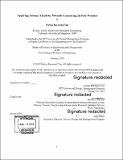| dc.contributor.advisor | Donna H. Rhodes. | en_US |
| dc.contributor.author | Tan, Peihao Raymond. | en_US |
| dc.contributor.other | Massachusetts Institute of Technology. Engineering and Management Program. | en_US |
| dc.contributor.other | System Design and Management Program. | en_US |
| dc.date.accessioned | 2019-07-18T20:30:25Z | |
| dc.date.available | 2019-07-18T20:30:25Z | |
| dc.date.copyright | 2019 | en_US |
| dc.date.issued | 2019 | en_US |
| dc.identifier.uri | https://hdl.handle.net/1721.1/121799 | |
| dc.description | Thesis: S.M. in Engineering and Management, Massachusetts Institute of Technology, System Design and Management Program, 2019 | en_US |
| dc.description | Cataloged from PDF version of thesis. | en_US |
| dc.description | Includes bibliographical references (pages 121-124). | en_US |
| dc.description.abstract | Carl von Clausewitz, a famous Prussian general and military theorist asserted that war's nature of being violent, interactive, and fundamentally political, does not change - only its character does. According to Clausewitz, the character of war is a dynamic phenomenon that manifests differently with the "spirit" of each age. In our current digital age, technology has heavily influenced interactions, including warfare. In addition to boosting traditional military means, technology has enabled rapid and widespread weaponization of social, information and infrastructural instruments for political coercion. A rising trend of combining national instruments of power to wage war simultaneously across the political, military, economic, social, information and infrastructural domains is a rapidly emerging threat, characteristic of modem "hybrid wars" being fought today. Traditional military-centric defense policies and strategies are ill-prepared to address such threats that deliberately operate in the "grey zone", playing on ambiguity and tailoring coercion to remain just below detection and response thresholds. In this research, a combination of literature review, descriptive study, inductive approach, normative research, case study and systems thinking are applied to analyze the hybrid warfare threat and then construct a suitable response framework, treating it as system with interrelated constituent parts, synergistically working together over time, within the wider international context, to deliver an emergent counter hybrid warfare capability. | en_US |
| dc.description.statementofresponsibility | by Peihao Raymond Tan. | en_US |
| dc.format.extent | 125 pages | en_US |
| dc.language.iso | eng | en_US |
| dc.publisher | Massachusetts Institute of Technology | en_US |
| dc.rights | MIT theses are protected by copyright. They may be viewed, downloaded, or printed from this source but further reproduction or distribution in any format is prohibited without written permission. | en_US |
| dc.rights.uri | http://dspace.mit.edu/handle/1721.1/7582 | en_US |
| dc.subject | Engineering and Management Program. | en_US |
| dc.subject | System Design and Management Program. | en_US |
| dc.title | Applying systems thinking towards countering hybrid warfare | en_US |
| dc.type | Thesis | en_US |
| dc.description.degree | S.M. in Engineering and Management | en_US |
| dc.contributor.department | Massachusetts Institute of Technology. Engineering and Management Program | en_US |
| dc.identifier.oclc | 1103606799 | en_US |
| dc.description.collection | S.M.inEngineeringandManagement Massachusetts Institute of Technology, System Design and Management Program | en_US |
| dspace.imported | 2019-07-18T20:30:23Z | en_US |
| mit.thesis.degree | Master | en_US |
| mit.thesis.department | SysDes | en_US |
